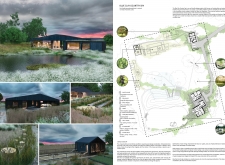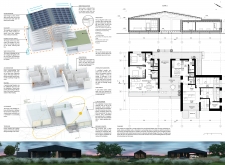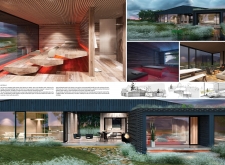5 key facts about this project
The project represents a modern interpretation of the traditional forms and materials found in the region, creating a dialogue between the old and the new. By incorporating local building techniques and materials, the design pays homage to the cultural heritage while embedding itself within the contemporary architectural narrative. The overall form of the building is characterized by clean lines and a fluidity that allows it to blend harmoniously with the landscape. The integration of natural elements into the design not only enhances the visual appeal but also contributes to the building's environmental performance.
Functionality is at the core of this architectural project. The layout has been meticulously planned to accommodate various activities, ensuring fluid movement and accessibility within the space. Zones with distinct purposes have been established while allowing for flexibility in usage. This adaptability is essential in creating a dynamic environment that can evolve alongside the needs of its occupants. By prioritizing user experience, the project emphasizes the importance of designing spaces that are not only aesthetically pleasing but also practical.
Among the project’s significant design elements, the façade stands out as a key feature. Constructed using a combination of concrete, glass, wood, and natural stone, it exemplifies a harmonious materiality that reflects both durability and warmth. The use of large window panels facilitates natural light penetration, which enhances the interior environment while connecting occupants to the outside landscape. Additionally, cleverly integrated shading devices help control solar gain, further enhancing the building's energy efficiency.
The landscaping surrounding the building plays a crucial role, integrating green spaces that invite communal interaction. Careful consideration was given to creating outdoor areas that not only extend the usable space but also promote biodiversity and sustainability. The blend of soft and hard landscapes creates a welcoming atmosphere, effectively dissolving the boundaries between built form and natural surroundings.
One notable aspect of this architectural design is the innovative approach to sustainability. The project incorporates advanced systems for energy efficiency, including [specific technologies like passive solar design, rainwater harvesting, or renewable energy sources], which significantly reduce its carbon footprint. These eco-friendly initiatives are seamlessly integrated into the design, allowing environmental responsibility to enhance aesthetic appeal rather than detract from it.
The overall architecture of the project successfully communicates a vision for the future—one that balances modernity with tradition and practicality with beauty. The design not only reflects the aesthetic values of contemporary architecture but is also deeply rooted in a commitment to enhancing the community's quality of life. The dynamic interplay of various architectural elements ensures that this space will continue to serve its intended function while adapting to the evolving needs of its users.
To gain an in-depth understanding of this architectural project, readers are encouraged to explore the architectural plans, sections, and designs. These elements offer insightful perspectives on the design intentions and implementation strategies behind this exceptional project. Delve into the architectural ideas that have shaped this building, revealing the thoughtfulness and innovation at its core.


























